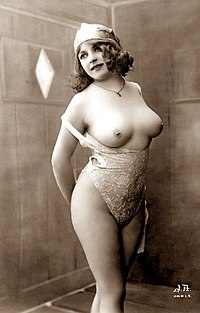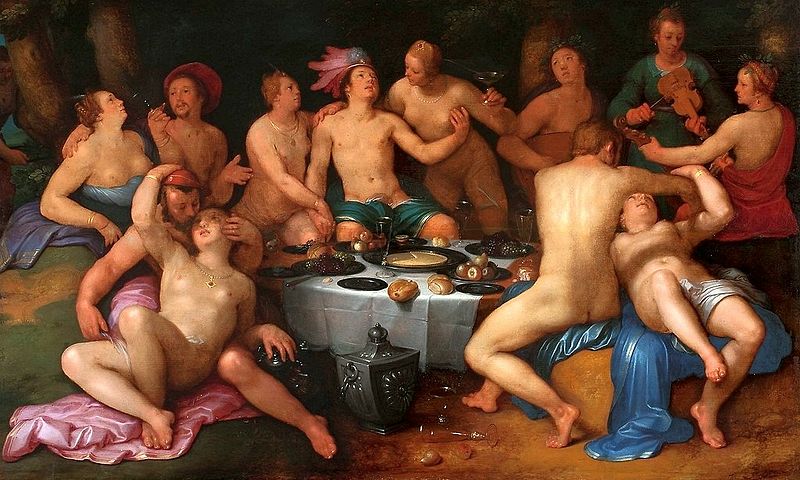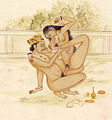Introduction

Pornography (colloquially known as porn or porno) has been defined as sexual subject material "such as a picture, video, or text" that is intended for sexual arousal. Made for the consumption by adults, pornography depictions have evolved from cave paintings, some forty millennia ago, to virtual reality presentations. A general distinction of adult content is made classifying it as pornography or erotica.
The oldest artifacts considered pornographic were discovered in Germany in 2008 CE and are dated to be at least 35,000 years old. Throughout the history of erotic depictions, various people made attempts to suppress them under obscenity laws, censor, or make them illegal. Such grounds and even the definition of pornography have differed in various historical, cultural, and national contexts. The Indian Sanskrit text Kama Sutra (3rd century CE) contained prose, poetry, and illustrations regarding sexual behavior, and the book was celebrated; while the British English text Fanny Hill (1748), considered "the first original English prose pornography," has been one of the most prosecuted and banned books. In the late 19th century, a film by Thomas Edison that depicted a kiss was denounced as obscene in the United States, whereas Eugène Pirou's 1896 film Bedtime for the Bride was received very favorably in France. Starting from the mid-twentieth century on, societal attitudes towards sexuality became more lenient in the Western world where legal definitions of obscenity were made limited. In 1969, Blue Movie became the first film to depict unsimulated sex that received a wide theatrical release in the United States. This was followed by the "Golden Age of Porn" (1969–1984). The introduction of home video and the World Wide Web in the late 20th century led to global growth in the pornography business. Beginning in the 21st century, greater access to the Internet and affordable smartphones made pornography more mainstream. (Full article...)
Erotica is literature or art that deals substantively with subject matter that is erotic, sexually stimulating or sexually arousing. Some critics regard pornography as a type of erotica, but many consider it to be different. Erotic art may use any artistic form to depict erotic content, including painting, sculpture, drama, film or music. Erotic literature and erotic photography have become genres in their own right. Erotica also exists in a number of subgenres including gay, lesbian, women's, bondage, monster and tentacle erotica.
The term erotica is derived from the feminine form of the ancient Greek adjective: ἐρωτικός (erōtikós), from ἔρως (érōs)—words used to indicate lust, and sexual love. (Full article...)
Selected article
Erotic literature comprises fictional and factual stories and accounts of eros (passionate, romantic or sexual relationships) intended to arouse similar feelings in readers. This contrasts erotica, which focuses more specifically on sexual feelings. Other common elements are satire and social criticism. Much erotic literature features erotic art, illustrating the text.
Although cultural disapproval of erotic literature has always existed, its circulation was not seen as a major problem before the invention of printing, as the costs of producing individual manuscripts limited distribution to a very small group of wealthy and literate readers. The invention of printing, in the 15th century, brought with it both a greater market and increasing restrictions, including censorship and legal restraints on publication on the grounds of obscenity. Because of this, much of the production of this type of material became clandestine. (Full article...)Selected work of erotic literature
Sex is a 1992 coffee table book written by American singer Madonna, with photography by Steven Meisel Studio and Fabien Baron. It was edited by Glenn O'Brien and published by Warner Books, Maverick and Callaway. The book features adult content including softcore pornography and simulations of sexual acts including sadomasochism.
Madonna developed Sex after Judith Regan of Simon & Schuster publishers suggested a book of erotic photographs. She wrote it as a character named "Mistress Dita", inspired by 1930s film actress Dita Parlo. It was influenced by punk rock and fashion figures including Guy Bourdin, Helmut Newton and Robert Mapplethorpe. The photos were shot in early 1992 in New York City and Miami, in locations including hotels, burlesque theaters, and city streets. The book includes cameos by actress Isabella Rossellini, rappers Big Daddy Kane and Vanilla Ice, model Naomi Campbell, gay porn star Joey Stefano, actor Udo Kier, and socialite Princess Tatiana von Fürstenberg. The cover is made of aluminium, spiral bound and wrapped in a Mylar sheet.
Madonna's publishers were apprehensive about the release and the book's commercial potential. It was released on October 21, 1992, the day after Madonna's fifth studio album Erotica. A CD single was also packaged with the book which contained the song "Erotic", a song similar in composition to her similarly named single "Erotica". It sold over 150,000 copies on its first day in the United States, and topped the New York Times Best Seller list for three weeks. In matters of days, Sex went on to sell more than 1.5 million copies worldwide and remains the best and fastest-selling coffee table book. It also remains as one of the most in-demand out-of-print publications of all time. (Full article...)List of selected works
|
|---|
Slideshow of selected contemporary images
Slideshow of selected historical images
Did you know (auto-generated) -

- ... that zombie pornography emerged in the 1980s during a rise in the Italian sexploitation film industry?
- ... that Koh Masaki was one of the first gay pornographic film actors in Japan to openly appear in adult films without obscuring his identity?
- ... that Lewes Road in Brighton has a gyratory named after a pornographic cinema?
- ... that Nickelodeon storyboard artists created a book with hundreds of pornographic drawings of SpongeBob SquarePants characters?
- ... that before being restored as a Broadway theater, the Ritz Theatre was used as a television studio, pornographic theater, vaudeville house, children's theater, and poster warehouse?
- ... that a pornographic screenplay about Jesus led to papal and royal condemnations, a firebombing, the writer's ban from the UK, and thousands of letters per week demanding the ban of a non-existent gay Jesus film?
- ... that Aroha Bridge changed its name from Hook Ups because fans searching for the show often found pornography instead?
- ... that Philipp Tanzer has been an army medic, artist, firefighter, hairdresser, massage therapist, festival organiser, political candidate and gay porn star?
Topics
Categories
Related portals
Associated WikiProjects
 |
 |
| Sexology and sexuality | Pornography |
Associated Wikimedia
The following Wikimedia Foundation sister projects provide more on this subject:
-
Commons
Free media repository -
Wikibooks
Free textbooks and manuals -
Wikidata
Free knowledge base -
Wikinews
Free-content news -
Wikiquote
Collection of quotations -
Wikisource
Free-content library -
Wikiversity
Free learning tools -
Wiktionary
Dictionary and thesaurus


























































![Image 8Indian Princess, by Richard Borrmeister [de] (1888?)](http://upload.wikimedia.org/wikipedia/commons/thumb/0/01/Richard_Borrmeister_Indische_Prinzessin_1888.jpg/102px-Richard_Borrmeister_Indische_Prinzessin_1888.jpg)












































